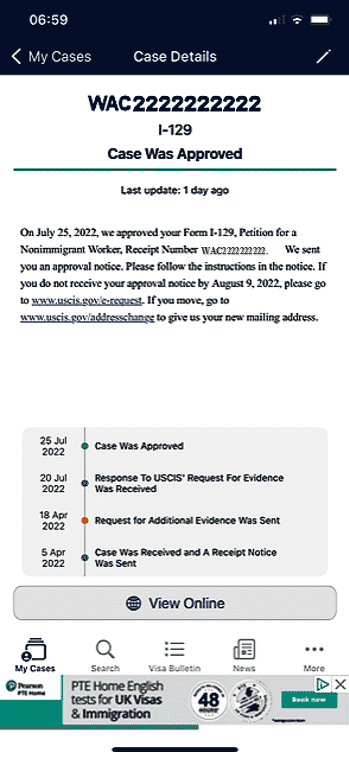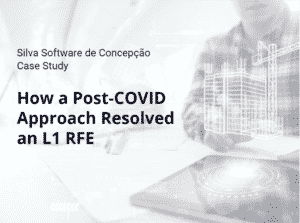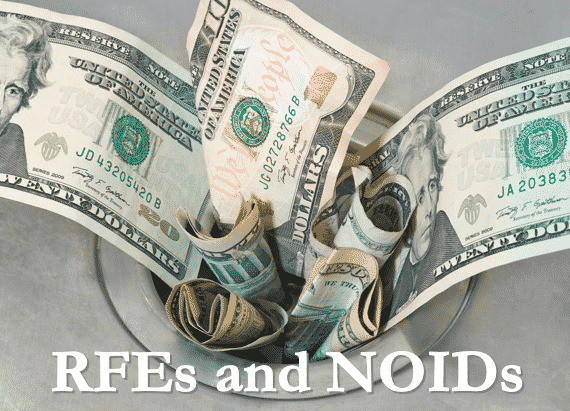RFE Responses
We are RFE and NOID specialists. Share your notice with us and we will provide a detailed proposal of what we believe needs to be done to answer it.
RFE and NOID Specialists
RFEs--Request for Evidence Responses
To most petitioners, an RFE means a step toward the denial of their application. We take a different view. While not a welcome response to an initial submission, it is nonetheless an opportunity. Why? An RFE is just that: It is a Request for Evidence. Usually, the USCIS wants more information or decides that the petition is completely missing some required information. The RFE is an opportunity to explain your petition in more detail to ensure that the adjudicator understands correctly what they are reading.
There are certainly times when you look at your documentation and wonder how they could have asked about something that was right in your plan already.
We have found that the best--and most successful--approach is to simply answer the RFE point-by-point. Using this approach, we have never had a second one issued once the first was answered.

Success depends on a timely, due diligent response that answers all points of the RFE
We thought we would share one of our recent successes: An approval of our response to an L1B Specialized Knowledge RFE. The WAC number has been altered for privacy but the outcome has not--it was a good one. It was a very complex one so we share our client's relief that it was accepted. The client has made a consular appointment and will be in the United States shortly.
We believe that our successful RFE and NOID responses result from a due diligent approach that is focused on answering all USCIS issues and questions. Whether or not we agree with the points raised is irrelevant: answering them thoroughly is still the only sure way to approval. This is not always the easy way because it is sometimes frustrating to have to answer parts of the RFE or NOID--especially if you don't think you should have to answer them.
In the end, however, it doesn't matter whether you want to answer the inquiry point by point: If you don't, you may not get your response approved. With your visa in the balance, this is no time to do anything but provide the best response possible.
HAVE YOU RECEIVED A RFE OR A NOID? If so, contact us and we will review it at charge; and we will tell you how we can help you resolve it.
According to the Policy Memorandum: SUBJECT: Issuance of Certain RFEs and NOIDs; Revisions to Adjudicator’s Field Manual (AFM) Chapter 10.5(a), Chapter 10.5(b) issued on July 13, 2018, RFE policy is defined as follows:
USCIS issues written notices in the form of a request for evidence (RFE) to request missing initial or additional evidence from applicants or petitioners who filed for immigration benefits.
When an RFE is appropriate, it should:
(1) identify the eligibility requirement(s) that has not been established and why the evidence submitted was not sufficient;
(2) identify any missing evidence specifically required by the applicable statute, regulation, or form instruction;
(3) identify examples of other evidence that may be submitted to establish eligibility; and
(4) request that evidence.

L1A RFE Case Study
This L1A RFE questioned--among other things--two primary inclusions in the application and a response was required that would adequately answer these questions to the satisfaction of the USCIS...
Download the Case Study Here
RFE Responses
We are RFE and NOID specialists. Share your notice with us and we will provide a detailed proposal of what we believe needs to be done to answer it.
NOIDs--Frightening But Not Always Fatal
Without question, a NOID--Notice of Intent to Deny, is serious and requires immediate attention. There are certainly instances in which it is difficult to get a NOID reversed: If you, your company or your regional center are engaged in illegal activities, resolution is unlikely. If you simply fail to meet the requirements for the visa for which you are applying, resolution may be difficult. For the latter, however, there are options since the situation can be presented to the USCIS in a new light. Time is of the essence here every bit as much as it is with an RFE.
Success depends on a timely, due diligent response that answers all points of the NOID.
Again, according to the Policy Memorandum: SUBJECT: Issuance of Certain RFEs and NOIDs; Revisions to Adjudicator’s Field Manual (AFM) Chapter 10.5(a), Chapter 10.5(b) issued on July 13, 2018, NOID policy is defined as follows:
A NOID may be based on evidence of ineligibility or on derogatory information known to USCIS, but the applicant, petitioner, or requestor is either unaware of the information or may be unaware of its impact on eligiblity. When an adverse decision is based on derogatory information that is unknown to the applicant, petitioner, or requestor, generally, an opportunity to rebut that information shall be provided in accordance with 8 CFR 103.2(b)(16)(i). In that situation, a NOID provides an applicant,
petitioner, or requestor with adequate notice and sufficient opportunity to respond and the opportunity to review and rebut derogatory information of which he/she/it is unaware. While not required in other situations, a NOID also provides an applicant, petitioner, or requestor with adequate notice and sufficient opportunity to respond to an intended denial on other substantive grounds.
When a preliminary decision has been made to deny an application or petition and the denial is not
based on lack of initial evidence or a statutory denial as discussed in Chapter 10.5(b), and 8 CFR
103.2(b)(16)(i) applies, the adjudicator must issue a written NOID to the applicant, petitioner, or requestor providing up to a maximum of 30 days to respond to the NOID. The NOID must include the required response date.
Types of RFEs/NOIDs We Answer
- E1 Treaty Trader and E2 Treaty Investor Companies
- EB1A Extraordinary Ability, EB1B Outstanding Professors and Researchers, EB1C Multinational Manager or Executive
- NIW National Interest Waiver
- EB5 Employment-Based Immigration/Immigrant Investor Program,
- L1A Intracompany Transfer Executive or Manager, L1B Intracompany Transfer Specialized Knowledge
Our RFE Response Approach
Whatever the case, we answer each request point by point. If one of the questions relate to something not in the business plan or economic study, we indicate where the answer to that question can be found. This allows for a cohesive response. We will coordinate assembly of all the information necessary to answer it--including information that is not normally within our purview.
Our responses are thorough and we assume responsibility for gathering and correcting any information in the business plan and/or the economic study.
Turnaround time is dependent on the time you have to answer the RFE. We will try to complete it as quickly as possible to accommodate an abbreviated timeline.
The Good News: If your business plan or economic study needs to be redone as part of the response, we are quite well-qualified to do that.
RFE
We are RFE and NOID specialists. Share your notice with us and we will provide a detailed proposal of what we believe needs to be done to answer it.
RFE Resources
Sample L1A Request for Evidence (RFE)
Sample EB5 Request for Evidence (RFE)
Includable Expenses for Job Creation (Download EB5 Interactive Series - Expenses)
Matter of Ho
Matter of Hsiung
Matter of Izummi
Matter Katigbak
Matter of Soffici
USCIS 1-485, I-765 RFE Information (Download USCIS I-485, I-765 RFE Information)
Policy Memorandum: Application RFE Response Time (Download Policy Memorandum: Application RFE Response Time)
Policy Memorandum: Requests for Evidence and Notices of Intent to Deny (Download Policy Memorandum: Requests for Evidence)
Learn More About It
Job Creation Includable Expenses
Eligible Hard Construction Expenditures, Soft Costs, and Transfers Hard Cost Construction Expenditures
• USCIS economists will typically ask for itemized information to ensure that only eligible costs are input into an accepted economic model or other methodology.
• Simply stated, total aggregate hard costs will likely be insufficient to demonstrate eligibility. Rather, costs should be broken down into specific expenditure categories (such as masonry work, plumbing, flooring, hardscaping, softscaping, etc.), so that USCIS economists can assess whether these costs are reasonable inputs.
• Certain types of evidence may strengthen the credibility of a filing. For example: If the assumptions are accompanied by a third-party market feasibility report, or if a developer shows a successful track record in completing similar projects. The important thing to remember is that the burden is on the petitioner to provide sufficient evidence.

